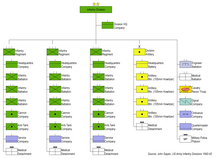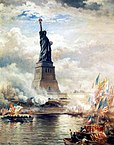77th Sustainment Brigade
| 77th Sustainment Brigade | |
|---|---|
Joint Base McGuire-Dix-Lakehurst | |
| Nickname(s) | "Statue of Liberty" (special designation)[1] |
| Engagements | World War I
|
| Commanders | |
| Current commander | Andrew D. Bruce Julius Ochs Adler |
The 77th Sustainment Brigade is a unit of the
The division is nicknamed the "Statue of Liberty Division"; the shoulder patch bears the Statue of Liberty in gold on a blue isosceles-trapezoid shape. U.S. Marines on Guam nicknamed them the "77th Marine Division".[not verified in body]
The
World War I
- Activated: 18 August 1917 Camp Upton in Yaphank, New York.
- Operations: Meuse-Argonne, Oise-Aisne.
The 77th Infantry Division consisted initially of draftees, mostly from

It was the first American division composed of draftees to arrive in France in World War I, landing in April 1918; overall, it was the seventh of 42 divisions to reach the Western Front. The division fought in the Battle of Château-Thierry on 18 July 1918 and later in the Meuse–Argonne offensive, the largest battle in the history of the United States Army, from late September until the Armistice with Germany on November 11, 1918. During its service in France, the 77th Division sustained 10,194 casualties: of these 1,486 men were killed and another 8,708 were wounded.
The division, after serving on occupation duties for the next few months, returned to the United States in April 1919 and was deactivated at Camp Upton later that month.

The 153rd Infantry Brigade consisted of the 305th Infantry Regiment, 306th Infantry Regiment, and 305th Machine Gun Battalion.[2] The brigade was initially commanded by Brigadier General Edmund Wittenmyer.[2]

The 154th Infantry Brigade was composed of the
While the division had been recruited as a National Army unit from the New York City area, attrition and replacements had complicated the complexion of the unit. For example, the 40th Division had been converted into a "depot division" in August 1918 to equip, train, and forward replacements to other units, and in the process, Company L of the 160th Infantry, part of the California National Guard, had supplied many of its original men to Company K of the 307th Infantry as replacements.
The "Lost Battalion" of World War I fame was composed of six companies of the 308th Infantry Regiment and one from the 307th Infantry Regiment.
- 77th Division Commanders:
- Maj. Gen. J. Franklin Bell (18 August 1917)
- Brig. Gen. Evan M. Johnson (4 December 1917)
- Maj. Gen. G. B. Duncan (8 May 1918)
- Brig. Gen. Evan M. Johnson (20 July 1918)
- Brig. Gen. Evan M. Johnson (19 August 1918)
- Maj. Gen. Robert Alexander (27 August 1918)
Order of battle
- Headquarters, 77th Division
- 153rd Infantry Brigade
- 305th Infantry Regiment
- 306th Infantry Regiment
- 305th Machine Gun Battalion
- 154th Infantry Brigade
- 307th Infantry Regiment
- 308th Infantry Regiment
- 306th Machine Gun Battalion
- 152nd Field Artillery Brigade
- 304th Field Artillery Regiment (75 mm)
- 305th Field Artillery Regiment (75 mm)
- 306th Field Artillery Regiment (155 mm)
- 302nd Trench Mortar Battery
- 307th Machine Gun Battalion
- 302nd Engineer Regiment
- 302nd Field Signal Battalion
- Headquarters Troop, 77th Division
- 302nd Train Headquarters and Military Police
- 302nd Ammunition Train
- 302nd Supply Train
- 302nd Engineer Train
- 302nd Sanitary Train
- 305th, 306th, 307th, and 308th Ambulance Companies and Field Hospitals
Interwar period
The 77th Division was reconstituted in the
The designated mobilization and training station for the division was
Although corps area commanders were nominally in command of the three Organized Reserve divisions in their corps area, with division chiefs of staff handling day-to-day operations, they sometimes designated junior Regular Army or Reserve general officers in their corps areas to serve as Organized Reserve division commanders in addition to their other duties. As of 1937, the 77th Division was commanded by Brigadier General Perry L. Miles, who was concurrently the commander of the 1st Division's 2nd Infantry Brigade.[4] Unlike the Regular and Guard units in the Second Corps Area, the 77th Division did not participate in the Second Corps Area maneuvers and the First Army maneuvers of 1935, 1939, and 1940, as an organized unit due to lack of enlisted personnel and equipment. Instead, the officers and a number of the enlisted reservists were assigned to Regular and Guard units to fill vacant slots and bring the units up to war strength for the exercises. Additionally, some were assigned duties as umpires or as support personnel. Due to the mobilization of many Organized Reserve officers beginning in 1939 for assignment to other units, all officers less those in the infantry and field artillery were relieved from their divisional assignments in July 1941 and assigned to branch pools instead.[5]
World War II



- Ordered into active military service: 25 March 1942, Fort Jackson, South Carolina
- Trained at Camp Hyder, California in 1943
- Overseas: 24 March 1944
- Campaigns: Western Pacific, Leyte, Ryukyus
- Days of Combat: 200
- Distinguished Unit Citations: 16
- Awards: Medal of Honor: 6; Distinguished Service Cross: 19; Distinguished Service Medal: 2; Silver Star: 335; Legion of Merit: 22; Soldier's Medal: 25; Bronze Star: 4,433; Air Medal: 4
- Commanders:
- Maj. Gen. Robert L. Eichelberger (March–June 1942)
- Maj. Gen. Roscoe B. Woodruff (June 1942 – May 1943)
- Maj. Gen. Andrew D. Bruce(May 1943 – 27 February 1946)
- Chaplain: Fray Angélico Chávez
- Inactivated: 15 March 1946 in Japan
Order of battle
- Headquarters, 77th Infantry Division
- 305th Infantry Regiment
- 306th Infantry Regiment
- 307th Infantry Regiment
- Headquarters and Headquarters Battery, 77th Infantry Division Artillery
- 304th Field Artillery Battalion
- 305th Field Artillery Battalion
- 306th Field Artillery Battalion
- 902nd Field Artillery Battalion
- 302nd Engineer Combat Battalion
- 233rd Engineer Combat Battalion
- 302nd Medical Battalion
- 77th Cavalry Reconnaissance Troop (Mechanized)
- Headquarters, Special Troops, 77th Infantry Division
- Headquarters Company, 77th Infantry Division
- 777th Ordnance Light Maintenance Company
- 77th Quartermaster Company
- 77th Signal Company
- Military Police Platoon
- Band
- 77th Counterintelligence Corps Detachment
Before Organized Reserve infantry divisions were ordered to active duty, they were reorganized on paper as triangular divisions. The 77th Infantry Division was ordered into active military service on 25 March 1942 around a cadre of officers and men from the
The next combat assignment was
Casualties
- Total battle casualties: 7,461[6]
- Killed in action: 1,449[6]
- Wounded in action: 5,935[6]
- Missing in action: 76
- Prisoner of war: 27[6]
21st century
Five soldiers from the 77th lost their lives at the World Trade Center in the September 11 attacks, while serving in their civilian duties.[7]
The lineage of the 77th Infantry Division is perpetuated today by the 77th Sustainment Brigade, a unit of the Army Reserve, with its headquarters at Fort Dix, N.J. In 2011, the brigade deployed to Iraq in support of Operation New Dawn. The brigade headquarters was stationed in Balad, Iraq and held logistical responsibility for the re-posturing of forces in northern Iraq. The unit's motto is "Liberty Warriors".[citation needed]
See also
- Desmond Doss, soldier of the 77th who received the Medal of Honor during the Battle of Okinawa
References
- Notes
- ^ a b "Special Unit Designations". United States Army Center of Military History. 21 April 2010. Archived from the original on 9 July 2010. Retrieved 9 July 2010.
- ^ a b c Center of Military History, United States Army (1988). Order of Battle of the United States Land Forces in the World War. Vol. 2. Washington, DC: US Government Printing Office. pp. 296–297 – via Google Books.
- ^ McGrath, The Brigade, 37
- ^ Cullum, George W. (1940). Farman, E. E. (ed.). Biographical Register of the Officers and Graduates of the U.S. Military Academy at West Point. Chicago, IL, Crawfordsville, IN: R.R. Donnelley & Sons Company, The Lakeside Press. p. 99 – via West Point Digital Library.
- ^ Clay, Steven E. (2010). U.S. Army Order of Battle, 1919-1941, Volume 1. The Arms: Major Commands and Infantry Organizations, 1919-41. Fort Leavenworth, KS: Combat Studies Institute Press. p. 244-245.
 This article incorporates text from this source, which is in the public domain.
This article incorporates text from this source, which is in the public domain.
- ^ a b c d Army Battle Casualties and Nonbattle Deaths, Final Report (Statistical and Accounting Branch, Office of the Adjutant General, 1 June 1953)
- ^ Capt. Jason Pyeatt (8 September 2012). "Fort Totten, Queens, New York 9/11/2001 Memorial Ceremony". 361st Public Affairs Operations Center. Retrieved 6 December 2013.
- Bibliography
 This article incorporates public domain material from The Army Almanac: A Book of Facts Concerning the Army of the United States U.S. Government Printing Office. United States Army Center of Military History.
This article incorporates public domain material from The Army Almanac: A Book of Facts Concerning the Army of the United States U.S. Government Printing Office. United States Army Center of Military History.- [1]
- Myers, Max. (ed.) Ours to Hold It High: The History of the 77th Infantry Division in World War II by Men Who Were There. Washington, D.C.: Infantry Journal Press, 1947.
https://archive.org/stream/OursToHoldItHigh#page/n1/mode/2up
Further reading
- Adler, Julius Ochs (ed.). History of the Seventy Seventh Division, August 25th. 1917 - November 11th. 1918. New York: The 77th Division Association, 1919. Pages 199-207 are devoted to a description of the "Lost Battalion".
- Klausner, Julius Jr. Company B, 307th Infantry: Its History, Honor Roll and Company Roster. New York: Burke-Kelly American Legion Post No. 172, 1920.
- McKeogh, Arthur. The Victorious 77th Division (New York’s Own) in the Argonne Fight. NY: John H. Eggers, 1919.
- Rainsford, Walter Kerr. From Upton to the Meuse with the Three Hundred and Seventh Infantry. New York: Appleton, 1920. Rainsford was commander of Company M, and later of Company L, of the 307th. This book contains a detailed account of the "Lost Battalion" in Chapter X (pages 195-224).
- Through the War with Company D, 307th Infantry, 77th Division. New York: 1919.
- Tiebout, Frank Bosworth. A History of the 305th Infantry. New York: 305th infantry Auxiliary, 1919. OCLC 3502040
- Whittlesey, Charles W. and George G. McMurtry. "The Epic of the Lost Battalion". The New York Times, 30 September 1928.
External links
- WWII Pacific Theatre: Campaign in the Marianas – Guam, 21–25 July 1944 a publication of the United States Army Center of Military History
- 77th Memorial Grove, Fort Totten, Bayside, NY
- U.S. Army 77th Infantry Division Expressway, Queens County, NYC
Ours To Hold It High: the history of the 77th Infantry Division in World War II

